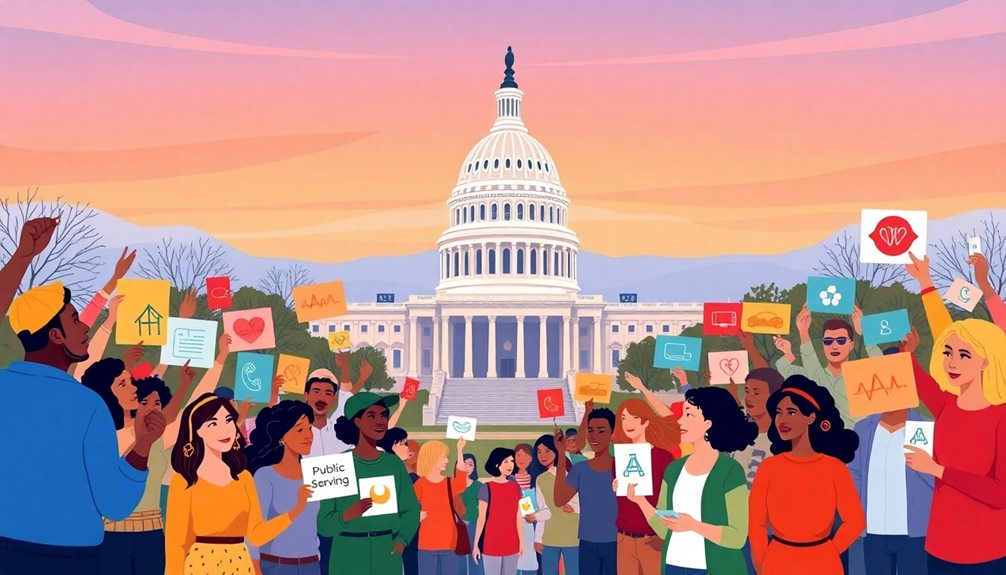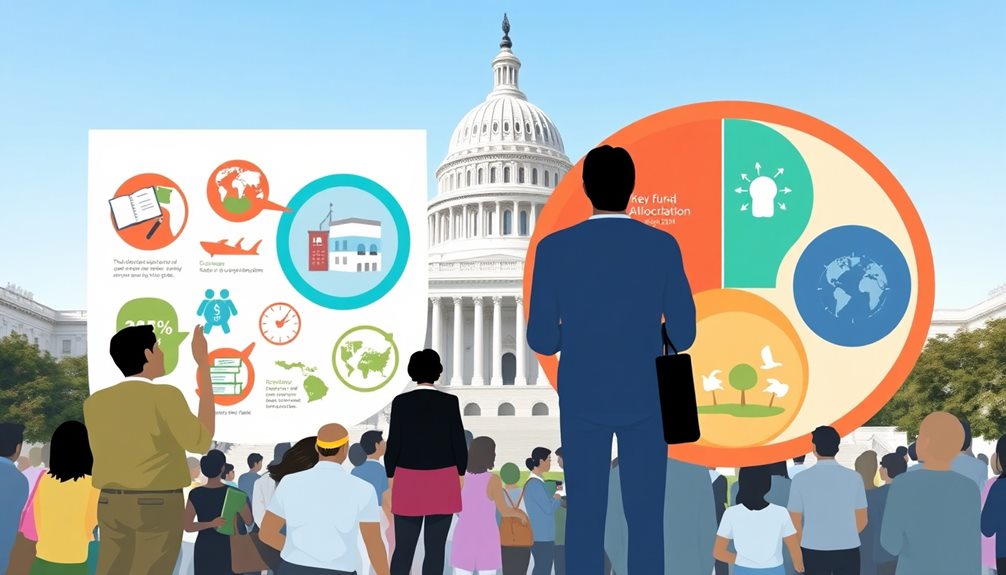The Senate's government funding bill offers several benefits that impact you directly. It secures essential funding for health care, education, and emergency services, ensuring stability through December 2024. You'll see improvements in local public health initiatives and disaster response thanks to increased FEMA support. If you rely on nutrition programs like SNAP or WIC, you're covered as these programs remain well-funded. Farmers benefit too, with resources directed toward agricultural productivity and rural development. This bill prioritizes your community's needs, so you can feel secure. There's much more to discover about how this funding can shape your everyday life.
Key Takeaways
- The funding bill secures essential government operations and programs through December 2024, providing stability for local communities.
- Increased funding for FEMA enhances disaster response capabilities, improving recovery efforts for affected areas.
- Child care and education programs receive prioritization, boosting access and support for families.
- Health care programs are funded at current levels, ensuring continued access to necessary medical services.
- Emergency assistance provisions, including clean water grants, support rural communities and enhance public health initiatives.
Overview of the Funding Bill

Passing with bipartisan support, the Senate government funding bill secures fundamental government operations through December 20, 2024. This legislation guarantees stable funding for various federal programs, reflecting a commitment to maintaining key services that impact your daily life.
With a significant vote from the House and Senate, the bill emphasizes appropriations for important areas, including emergency preparedness and health care.
The bill provides full-year funding for the Federal Emergency Management Agency (FEMA), which plays a significant role in disaster response. This means that when emergencies arise, you'll have confidence in the federal government's ability to respond effectively.
Additionally, health care programs will continue receiving funding at current levels, guaranteeing stability for initiatives that directly affect your health and well-being.
Moreover, the legislation delays cuts to the clinical lab fee schedule for a year, supporting clinical labs across the country. By maintaining these necessary funding streams, the bill helps secure continuity of fundamental services that you rely on.
Key Funding Allocations

The Senate government funding bill outlines specific allocations that directly impact various sectors. You'll see significant funding designated for essential departments like State, Homeland Security, and Defense, ensuring smooth operations and services.
The House has prioritized child care and education programs, boosting access to quality services for families and children, which is fundamental for community development.
In the area of health care, the bill emphasizes medical research initiatives, promoting advancements that can lead to better treatments and public health programs. This funding is essential for driving innovations that improve health outcomes across the nation.
Additionally, the bill allocates funds for the Border Patrol, addressing national security concerns and reinforcing immigration enforcement efforts.
One of the standout features of this funding package is its support for the PEPFAR initiative. This program has saved over 25 million lives globally through its extensive HIV/AIDS treatment and prevention programs, showcasing the U.S. commitment to global health.
Impact on Local Communities

Many local communities will feel the effects of the Senate government funding bill as it secures essential support for federal programs. The continuing resolution (CR) guarantees stable funding levels for critical programs through December 20, 2024, which means you'll continue to benefit from crucial health care and emergency services.
In places like Fort Worth, Texas, this funding can enhance community programs that celebrate local heritage and provide necessary resources for public health initiatives. With FEMA's full-year appropriation, your community can enhance disaster response and recovery efforts, helping those affected by natural disasters get back on their feet faster.
Public health programs funded at current levels will maintain local health services, allowing for important initiatives like vaccination campaigns and health education to thrive.
Additionally, rural development programs included in the CR promote investments in infrastructure, housing, and utilities, which can drive economic growth and improve living conditions for you and your neighbors.
Nutrition programs such as SNAP and WIC receive continued support, directly impacting food security for families in your community. This funding helps guarantee that everyone has access to nutritious food, which is more important than ever.
Support for Agriculture Programs

The Senate government funding bill prioritizes farm production funding, ensuring that farmers have the resources they need to boost productivity.
You'll also see support for rural development initiatives that enhance living conditions in these communities.
This combination aims to strengthen both agriculture and the rural economies that depend on it.
Farm Production Funding
Farm production funding plays an essential role in supporting agriculture programs that guarantee food security and bolster rural economies. The Senate government funding bill allocates significant resources for farm production programs, securing critical financial assistance for agricultural initiatives. Title II of the package enhances sustainability through conservation efforts, directly impacting your community.
Here's a quick look at what this funding could mean for you:
| Program | Benefits | Target Groups |
|---|---|---|
| Farm Production Programs | Increased crop yields | Farmers |
| Financial Assistance | Support for low-income families | Rural communities |
| Supplemental Nutrition Assistance Program (SNAP) | Access to nutritious food | Low-income households |
| Rural Economic Development Initiatives | Improved infrastructure | Farming communities |
Additionally, the bill emphasizes aid for domestic food programs like SNAP and Women, Infants, and Children (WIC), which are vital for food security among low-income families. This all-encompassing approach guarantees you're not just supporting local agriculture but also investing in the well-being of your community. With this funding, you're looking at brighter prospects for rural economic development and a more secure food supply.
Rural Development Support
Rural development support is essential for enhancing the quality of life in agricultural communities. The Senate government funding bill allocates important resources to improve housing, utilities, and infrastructure in rural areas, ensuring that you and your neighbors can thrive.
By investing in agriculture, the bill supports sustainable practices, which are critical for maintaining the resilience of rural economies.
One key aspect of this support is the inclusion of the Special Supplemental Nutrition Program for Women, Infants, and Children (WIC). This program addresses food security for vulnerable populations, making sure that families in your community have access to nutritious food.
Additionally, the Commodity Assistance Program plays a significant role in providing food assistance to low-income individuals, further improving food security in rural communities.
Moreover, the legislation targets rural economic development through various initiatives, fostering job creation and enhancing overall community welfare.
By focusing on these assistance programs, the bill not only strengthens agriculture but also uplifts the lives of those who depend on it.
With these efforts, you can expect a brighter future for your agricultural community.
Emergency Assistance Provisions

In response to urgent community needs, the Senate government's funding bill introduces several vital emergency assistance provisions. One of the key components is the Emergency Community Water Assistance Grant Program, designed to help communities struggling with inadequate drinking water supplies. This program aims to guarantee that you have access to safe and clean water during emergencies.
Additionally, the bill allocates emergency supplemental appropriations specifically for disaster-related activities. This funding enables quicker responses to natural disasters, allowing your community to recover more effectively. The monitoring of Food for Peace Act funds is also essential, as it guarantees that aid reaches those in need during crises.
Moreover, technical assistance is provided to rural hospitals, enhancing their operations and promoting better health outcomes in underserved areas, like yours. This support aims to guarantee that you receive the care you need, especially during challenging times.
Lastly, the bill maintains restrictions on procuring poultry products from China for various school food programs, prioritizing food safety and quality for your children. These provisions collectively strengthen the safety net for families and communities facing emergencies.
Future Legislative Considerations

As discussions around future legislative considerations heat up, it's crucial to pay attention to the implications of the continuing resolution (CR) effective until December 20, 2024. This CR sets the stage for future congressional action regarding federal funding, but it also raises several key considerations:
- Budget Authority: You'll need to keep an eye on how this CR affects agencies' budget authority as they prepare for potential adjustments.
- Appropriations Bills: Future appropriations bills will be critical in allocating resources, and stakeholder engagement will shape these priorities.
- Bipartisan Support: The success of passing these bills hinges on maintaining bipartisan support, especially amidst shifting political dynamics.
- Long-term Planning: Evaluating the impacts of the current CR on long-term budget planning is crucial, given the fiscal challenges ahead.
As the expiration date approaches, ongoing monitoring of federal funding needs will be important.
Engaging with stakeholders can help address emerging priorities effectively, ensuring that legislative actions align with the nation's needs. Your awareness and involvement in this process can make a difference in shaping the future of federal funding.
Frequently Asked Questions
What Is in the New Government Spending Bill?
The new government spending bill funds operations through December 20, 2024, preventing a shutdown.
You'll see full-year funding for FEMA and support for key health care programs.
It delays cuts to clinical lab fee schedules, providing relief to labs.
The bill also extends public health authorizations and allocates resources for disaster relief and emergency preparedness.
Is the Government Funded for 2024?
You've dodged a bullet with the government funded for 2024!
The Senate passed a continuing resolution that keeps operations running smoothly until December 20, 2024.
This means essential services, including health care programs and FEMA, will receive uninterrupted funding.
You can breathe a little easier knowing that a government shutdown is off the table for now, though more funding discussions lie ahead as the deadline approaches.
What Is the Senate Government Shutdown Bill?
The Senate government shutdown bill, known as the continuing resolution (CR), funds government operations through December 20, 2024.
It's designed to prevent a government shutdown. With bipartisan support, it passed both the Senate and the House.
Key features include full-year funding for FEMA, maintaining health care programs, and delaying clinical lab fee cuts for one year.
This bill guarantees stability for federal programs and sets the stage for future budget discussions.
What Is in the Continuing Resolution Bill?
Imagine it's the 90s and you're worried about your favorite TV show getting canceled. The continuing resolution (CR) guarantees the government's funding stays steady, preventing disruptions.
FEMA's got full-year funds, so emergency services are primed. Public health programs won't skip a beat, and clinical labs avoid fee cuts for a year.
Plus, various federal projects continue without a hitch, giving you peace of mind about essential services in your community.
Conclusion
In the grand theater of government, this funding bill plays a pivotal role in shaping your community's future. With critical allocations for agriculture and emergency assistance, it's like a lifeline thrown into turbulent waters. As you navigate the implications, remember that your voice matters. Engage with your representatives and advocate for what aligns with your needs. Just as the phoenix rises from the ashes, your involvement can help create a thriving environment for all.










